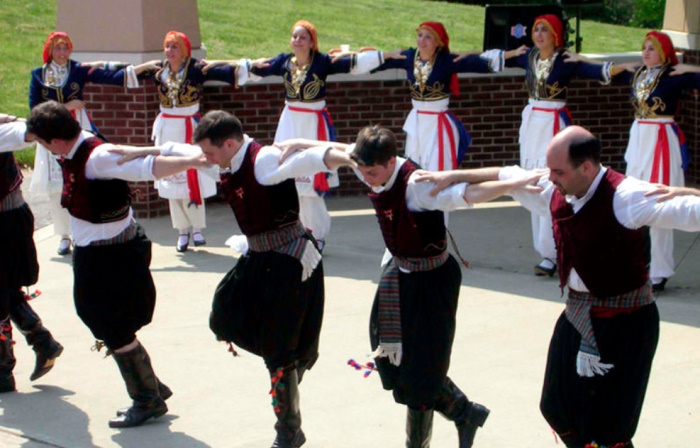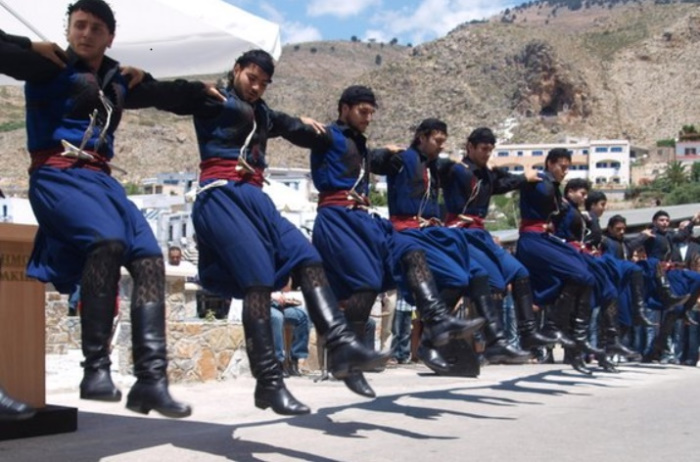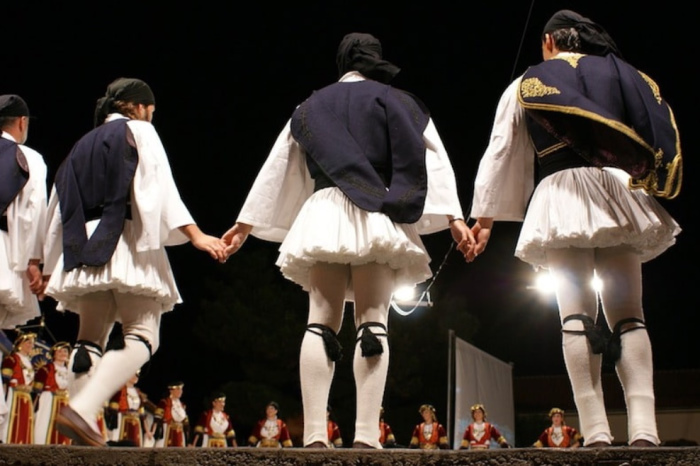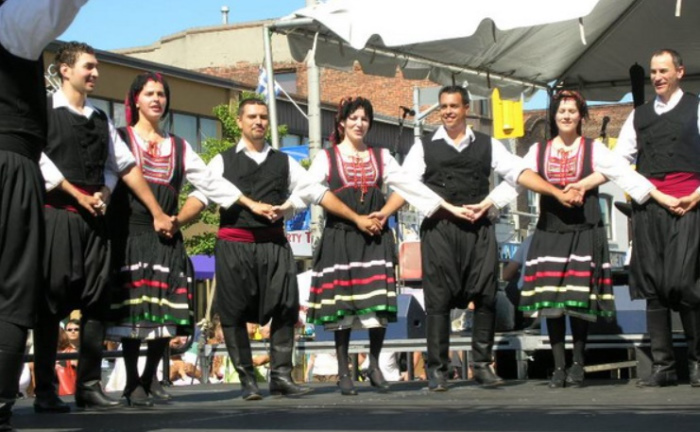Choosing only a couple of traditional Greek dances was difficult, especially as the people here believe God taught humans how to dance as a blessing, a favor.
Once a ritual for solemn ceremonies, most of these dances have become social dances that bring everyone closer or training methods for a healthy body.
Table of Contents
List Of Popular Traditional Greek Dances
Through thousands of years of building a culture and staying loyal to the tradition, Greek ascendants created and preserved over 10,000 dances throughout their history.
Even though some of them are lost forever, some still survive. Therefore, we have handpicked the most popular dances from that endless list.
Ballos
Ballos is one of the dances originally from Greece with strong Greek elements. Its name can be directly translated to “dance” or “jump, indicating the joyous vibe of the movements.
The unique sensation also comes from “Nisiotika”, a music form played by violin and lute.
In the old culture of Greece, it wasn’t appropriate for men to court women.
Thus, they came up with this dance and also had many variations with more than one couple doing the dance, giving many enthusiasts the same impression as the Minuet dance.
The male and the female dancers taking part in Ballos have significantly different outfits.
The men have a white shirt with long sleeves, black pants, a maroon coat, stockings, a waistband, a black hat, and comfortable shoes.
Meanwhile, the women will wear a more colorful shirt with a white apron, a flowy skirt, a headgear, a belt, and of course shoes they deem fit.
The essence of the performance is about a person with flirtatious intentions to the other who doesn’t respond to all the initiatives, hence the elements included in the dance are usually seductive.
You can only learn it by visiting the Aegean islands or simply watching online videos.
Check more: List of Traditional French Dances
Hasapiko
Meaning “a dance of the butcher”, Hasapiko is a dance with origins from the Middle Ages, although it was a battle mime at first.
During the Byzantine era, people referred to it as “makellárikos horós”, yet many Greek folks believe it was more likely the quickened version.
The most common version you will hear of today is “Hasaposerviko” or “Serbian Hasapoko”, in which the pace goes from slow to fast, and the influences mostly come from Balkan countries.
Although the dance was performed with swords, it no longer includes these props. The performers nowadays wear buttoned shirts with hats, coats, and pants of the same colors.
They dance on the accompaniment of bouzouki or baglamas. As time went on, the santouri and violin became part of the band.
Hasapiko inspired choreographers to come up with Sirtaki, which is now known as a modern variation of it. The way the dancers put their hands on one another’s shoulders is maintained in both dances.
Did you know: Lion Dance?
Ikariotikos
Also known as “Kariotikos” by the locals, it is a mutual name for a song and its accompanying dance originating from Ikaria, a Greek island in the northeastern region of the Aegean Sea.
According to Greek myths, it was where Icarus fell after flying too near the sun and getting his wings burnt.
The song that accompanies this dance most of the time now is “My Love of Ikaria”. The musicians often use modern sounds for it, unlike in the old days, when people used traditional instruments like lyre, violin, laouto, tsabounofilaka, and percussion tools.
Due to the movements and the rhythms, Ikariotikos is the slowed version of Ballos, the dance we previously mentioned, to many culture researchers.
However, the experts will warn you not to see and perform Ikariotikos as a belly dance. The outfits for the performers have nothing to do with belly dancing either with most items being black.
You are likely to catch the Ikariotikos dance in all sorts of big events on its mother island: baptisms, religious festivals, wedding ceremonies, or parties.
The performance is typically divided into three sections, with each part being faster than its preceding one.
Kalamatianos
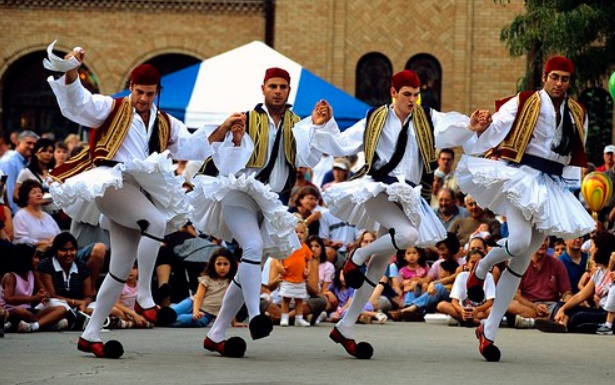
Kalamatianos appears frequently in Greek dance history with its roots pointing back to antiquity. In the 1800s, people called it “Syrtos O Peloponisios” before it adopted the name from the Kakamata town.
As a popular folk dance in Greece, Kalamatianos can include a rather large group of participants who hold hands and dance in a counterclockwise direction while maintaining the chain formation.
As Kalamatianos is extremely well-known for the Greeks, the songs coming with the dance vary greatly depending on the region, yet the most prominent signature is “Mantili Kalamatianos”, in which a maiden asks her lover to bring a silk scarf from Kalamata to her.
Whenever there is a village gathering, they will have lively music, drinks, food, and hours to dance. It is open to everyone, so don’t hesitate to join the circle and have a great experience for yourself!
Pentozali
Combined with “penti” (five) and “zalos” (step), Pentozali can be translated to “five steps”. Furthermore, “zali” is the term for dizziness, indicating that the performers will have their heads spinning five times harder.
In a more symbolic sense, it demonstrates the fifth attempt of the Greek people to free themselves from the Ottoman Turks.
History told a story of Turkey’s armies planning to invade Crete and eliminate all rebels.
However, when Cretan folks started performing Pentozali, the rigorous motions scared the Turkish soldiers off, and the dance became a method to demoralize the enemies.
Due to that liberty aspect of the dance, Pentozali has a strong sense of martial arts in its movements and the performers tend to be men only.
They are all required to execute vibrant and energetic moves on constantly changing tempos, hence new dancers might find the dance a little difficult to catch up.
For the performance, the main instrument is a Cretan lyra and a lauto, and the lyrics are optional. The dancers will also dress in Cretan outfits, including a shirt and a dark-colored “vraka” (pants with a tight waistband and loose hips).
Podaraki
Originating in the 10th century, Podaraki completely deserves to have a spot among classical Greek dances.
Today, it is nothing foreign for the northside of Thrace as well as Turkey, especially during social events.
Directly translated to “a small foot” in the Greek language, the dance is a set of quick stomping movements that both men and women can do with enough training. The circle formation is much more popular than the line version.
Nonetheless, the song of Podaraki is all about a girl calling for her friends to have fun before marriage.
In the second part, the main character expresses disappointment and distress toward the criticism targetting and restraining women from living the life they want and finally seeks revenge.
Aside from the absence of restrictions for outfits, the health benefits Podaraki brings are another reason for its popularity.
The experts have proven that the continuous and quick steps of this dance can enhance your balance, better your cardiovascular condition, and put you in a good mood.
Sirtaki
Sometimes read as Syrtaki, Sirtaki is a fairly new Greek dance compared to the older choreography pieces.
It was only created in 1964 for the drama flick “Zorba the Greek” and had an exclusive song written for it with the same name by the critically acclaimed Mikis Theodorakis.
Dance experts quickly pointed out that Sirtaki has elements of several dances put together. They were able to spit the slow Hasapiko moves, the quicker Hasaposerviko steps, and the hopping of Syrtos.
As said and shared by the actors who had to practice the dance for the filming, the hopping motion was quite a challenge to conquer if you have minor injuries. It might be a clear indicator of Sirtaki’s difficulty level.
Both line and circle formations are good for this dance. The performers have their arms on each other’s shoulders and use their legs to demonstrate the act of crushing grapes.
Sousta
Another creation of the largest island in Greece, Crete, Sousta has climbed the popularity ranking to become a mainstream choreography for a duo, known as a complex dance.
It isn’t too different from a dance for couples, with a man and a woman linking arms and moving in the normal clockwise direction. After a circuit, they will face each other, separate, and rejoin soon enough while the music is still playing.
Being a cheerful dance, Sousta is a chance for women to wear long colorful skirts with pretty headscarves, while the men stay true to the gentleman’s look and adorn white shirts with matching black vests and pants.
Besides Crete, this dance is nowadays performed in various Greek cities for celebrations and parties.
Syrtos
First described in the 2nd century, Syrtos is one of the oldest dances that we are lucky enough to still see today. It has always been hard to replace in religious festivals and social gatherings along with Kalamatianos.
Most noticeably, in 1803, women captured by the Turkish armies danced to Syrtos before throwing themselves off the cliff in Zalongo. Therefore, part of the history referred to Syrtos as a symbol of something tragic yet unbelievably brave.
The traditional Syrtos have two separate lines for men and women, though the boundary has become blurred with less discrimination for both genders.
They usually wear traditional Greek costumes and form a line or a circle, depending on the leader and the space they have.
Among Greek dances, Syrtos is perhaps the chain dance with the most variations, including Syrtos Koftos, Cretan Syrtos, Politiko Syrto, Syrto Kefallonias, and many more.
Tsakonikos
Coming from Arcadia (more widely known as “Tsakonia” there), it is part of the Peloponnese culture and is frequently performed in local towns or villages.
The formation of Tsakonikos is rather unique with an open circle curling into its center and shaping a spiral symbolizing a labyrinthine.
Legends have it related to Theseus’ Crane dance as the mythic hero ventured into the Labyrinth of Minos and slain Minotaur. Another link pointed to the lore about Apollo killing Delphi’s Python.
While the origins vary greatly, the versions of Tsakonikos are not too different from each other and the quintessence of the dance is properly maintained.
Through a negotiation to investigate whether human bodies can become vehicles of cultural values or not, the precedents proved to us that the snake form of Tsakonikos is an embodiment of our connection with external factors. It also plays an important role in health improvement.
Tsamiko
Meaning “the dance of the Chams” with an alternative name of “the dance of the Klephts”, Tsamiko was closely associated with the Greek War of Independence, in which the Klephts participated.
In the old days, Tsamiko was more commonly seen in national celebrations such as Greek Independence Day. The male dancers would adorn traditional Greek dance costumes called “fustanella” – a pleated skirt men in Balkan countries used to wear.
However, our days witness Tsamiko appearing more regularly in festive occasions like weddings and gatherings with both genders partaking in it, especially in minor regions of Thessaly, Epirus, or Central Greece where the dance is remarkably slower.
According to the veterans, the keys of Tsamiko are grace, attitude, and style. While the steps of Tsamiko are not too challenging, it is mandatory for the dancers to be precise with the beats.
Zeibekiko
Unlike most of the dances we have included in this list, Zeibekiko is less of a group performance and more like a collection of solo parts, though it was originally a duo with both dancers armed like soldiers.
Without a specific set of moves to execute, it gives the dancers so much room for creativity. Requiring so much improvisation and boldness, Zeibekiko used to be considered a male-only dance with intensity.
However, as women gradually proved their capability and expressed themselves better, they became part of the performance too.
The performers usually dance to Zeibekiko with additional feats such as standing on a fireplace or a glass of wine or lifting a table to show a sense of humor or braggadocio.
Nowadays, the intensity has faded, thus allowing the dance to be a regular part of ceremonies and social gatherings.
More specially, there will be a song list and each dancer has a separate track. For Greeks, when someone is doing their solo, no one should occupy the stage or disturb them.
Zonaradiko
When you talk about Thrace, it is almost impossible to ignore the traditional dance Zonaradiko. The name comes from the word “zonaria” (belt) because the dancers will hold tightly on the neighbor’s belt during the performance.
Although Zonaradiko is widely popular across the territory of Greece with many variations, the essence of the dance is maintained quite well.
Many people say Zonaradiko is very similar to the Bulgarian dance Pravo, and they are not entirely wrong. These two dances are the exact same thing, though they are dedicated to two different countries.
With the involvement of both men and women, Zonaradiko is a frequent Greek dance at weddings or any social events that might require a dance performance. The dancers usually learn from each other instead of a dance class!
Final Words
Certainly, our list of traditional Greek dances only contains a very small part of the legacy the Greeks have shared with the world.
If you have a personal favorite and want to share with us, we will be extremely delighted! It’s these small actions that keep the cultural value surviving and thriving through all the events in history.

